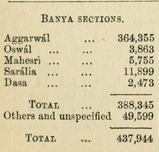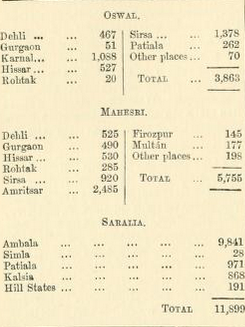The Divisions of the Banya Caste
(Created page with " {| class="wikitable" |- |colspan="0"|<div style="font-size:100%"> This article is an extract from <br/> PANJAB CASTES <br/> SIR DENZIL CHARLES JELF IBBETSON, K.C. S.I. <br...") |
(→The divisions of the Banya Caste) |
||
| (3 intermediate revisions by one user not shown) | |||
| Line 54: | Line 54: | ||
section 259, Chapter IV). But the great mass of them are Hindus, and almost invariably of the | section 259, Chapter IV). But the great mass of them are Hindus, and almost invariably of the | ||
Vaisbnava sect. | Vaisbnava sect. | ||
| − | |||
| − | |||
| − | |||
Banya | Banya | ||
| Line 68: | Line 65: | ||
and when Jains, almost .always of the Swe | and when Jains, almost .always of the Swe | ||
tambara sect. | tambara sect. | ||
| + | [[File: 495.png | |frame|500px]] | ||
The third or north-western section is | The third or north-western section is | ||
| Line 96: | Line 94: | ||
I able to discover nothing regarding their origin or the distinction lietween them and | I able to discover nothing regarding their origin or the distinction lietween them and | ||
the other sections of the caste. | the other sections of the caste. | ||
| − | |||
| − | |||
| − | |||
| − | |||
The Dasa Banyas are not properly a distinct section of the caste. The word means hybrid | The Dasa Banyas are not properly a distinct section of the caste. The word means hybrid | ||
and is used for members of other castes who have departed from the custom of the caste or | and is used for members of other castes who have departed from the custom of the caste or | ||
| Line 111: | Line 105: | ||
Mahesri, are said not to intermarry. The Banyas possess the Brahminical cjotras, but it appears | Mahesri, are said not to intermarry. The Banyas possess the Brahminical cjotras, but it appears | ||
that they also have other sub-divisions of the main sections of the caste. | that they also have other sub-divisions of the main sections of the caste. | ||
| + | |||
| + | See[[The Dhunsar ]] | ||
Latest revision as of 13:08, 2 May 2014
This article is an extract from PANJAB CASTES SIR DENZIL CHARLES JELF IBBETSON, K.C. S.I. Being a reprint of the chapter on Lahore: Printed by the Superintendent, Government Printing, Punjab, 1916. Indpaedia is an archive. It neither agrees nor disagrees |
[edit] The divisions of the Banya Caste
The divisions of the Banya caste with which we are coucerned in the Panjab are shown in the margin. The Aggarwals or north-eastern division of Banyas include the immense majority of the caste in every district throughout the Province. They have, according to sherring, a tradition of of a far distant origin on the banks of Godavery. But the place to which all Aggarwals refer the origin of the sectior, and from which they take their name, is Agroha in tfte Hissar district, once the capital of a Vaisya Raja of the name of Agar Sen, and whence they are said to have spread over Hindustan after the taking of that place by Shahab-ul-din Ghori in 1195; and Elliott points out that the fact that throughout the North-Western Provinces the Aggarwal Banyas are supposed to be specially bound to make offerings to Guga Pir, the great saint from the neighbourhood of Agrolia, bears testimony to the truth of the tradition. The eighteen sons of Agar Sen are said to have married the eighteen snake-daughters of Raja Basak, and Guga Pfr is the greatest of the snake-gods. The Aggarwals are often Jain, especially in Dehli and among the more wealthy classes of the cities; and when .Tains, are generally of the Digauibara sects (see section 259, Chapter IV). But the great mass of them are Hindus, and almost invariably of the Vaisbnava sect. Banya
The Oswals or south -western section of the caste trace their origin from Osia or Osnagar, a town in !Marwar. Their distribution in the Panjab is shown in the margin; their real. home is in Gujarat and South-Western Rajputana, where they are exceedingly numerous. They are very generally Jains, and when Jains, almost .always of the Swe tambara sect.
The third or north-western section is Mahesri who are most numerous in Bikaner. Mr. Wilson says that those of Sirsa claim Rajput origin, and still have sub-divisions bearing Rajput names. They say that their ancestor was turned into stone for an outrage upon a faqir, but was restored to life by Mahesh or Mahadeo hence their name. Their distribution in the Panjab is shown in the margin. They are for the most part Vaishnava Hindus, though occasionally .Tains. Their relations with the Aggarwals are much closer than are those of the Oswals.
The Saralia Banyas are returned in the localities shown in the margin. They are a branch of the Aggarwals, but owing to some dispute left Agroha and settled in Sarala, a town not far from Agroha, from which they take their name. They are as strict as other Aggarwals, and not in any way data or impure. They do not inter TOTAL 11,899 marry with other Aggarwals. I have been
I able to discover nothing regarding their origin or the distinction lietween them and the other sections of the caste. The Dasa Banyas are not properly a distinct section of the caste. The word means hybrid and is used for members of other castes who have departed from the custom of the caste or whose descent is not pure. The Dasa Banyas are said to be descendants of an illegitimate son of an Aggarwal. To the figures given for them above should be added 1,664 in Ambala who have returned themselves as Gata, which is a synonym for Dasa.
Little appears to be known of the minor sub-divisions. It is to be hoped that the detailed tables of sub-divisions of castes now in course of preparation from the papers of the Panjab Census will tell us something about them. The three great sections, Agarwal, Oswal and Mahesri, are said not to intermarry. The Banyas possess the Brahminical cjotras, but it appears that they also have other sub-divisions of the main sections of the caste.
SeeThe Dhunsar

